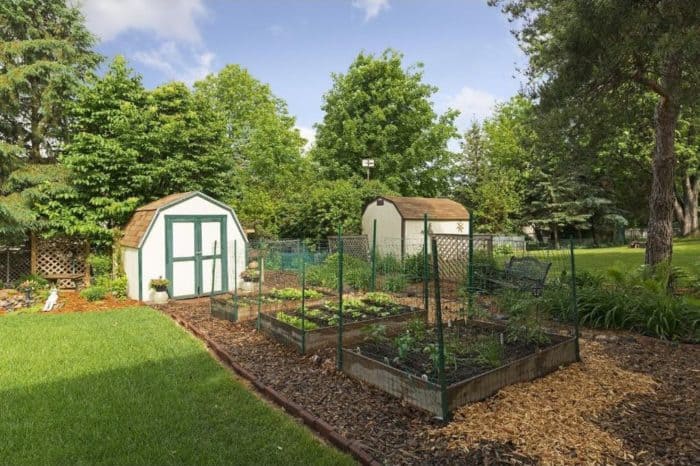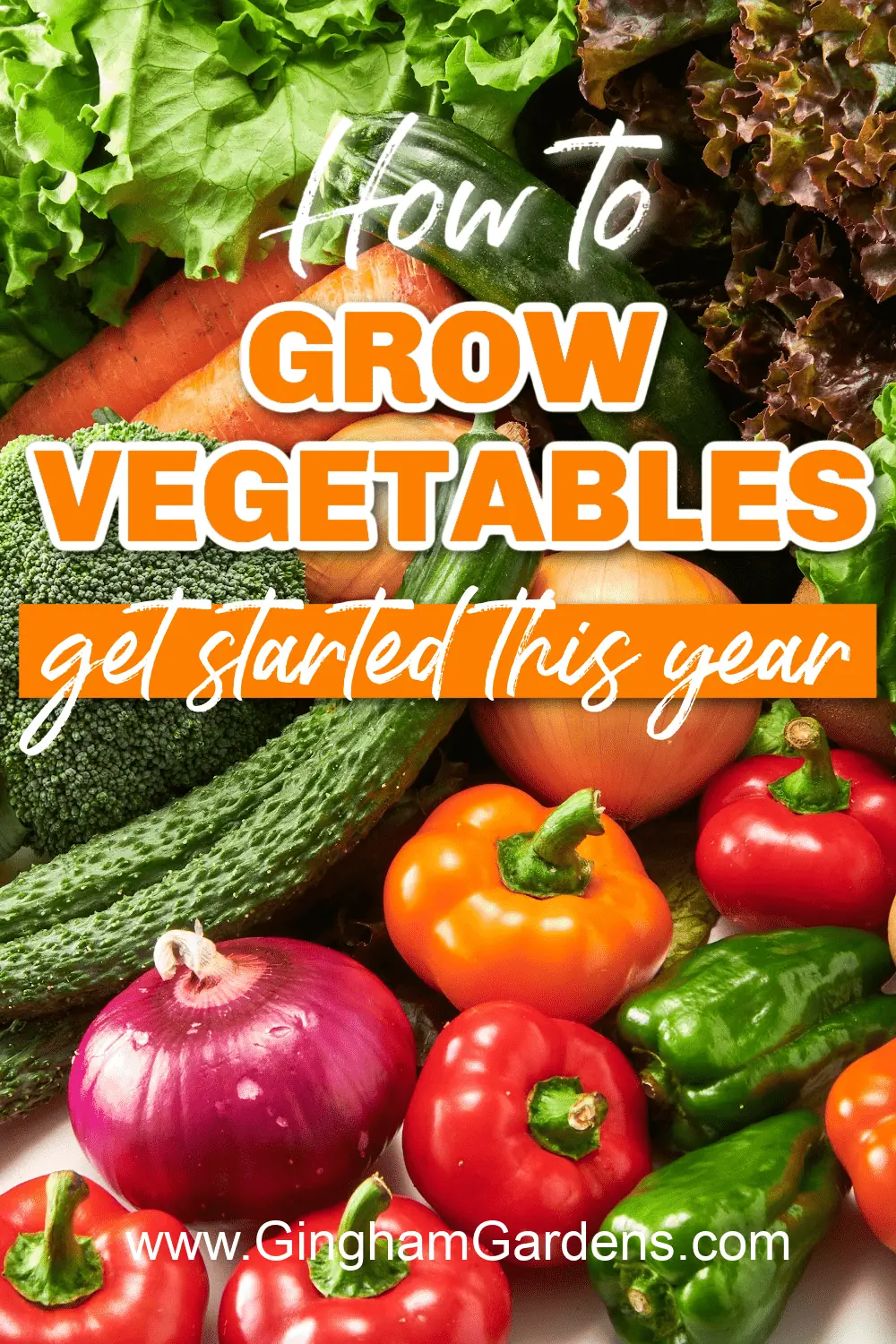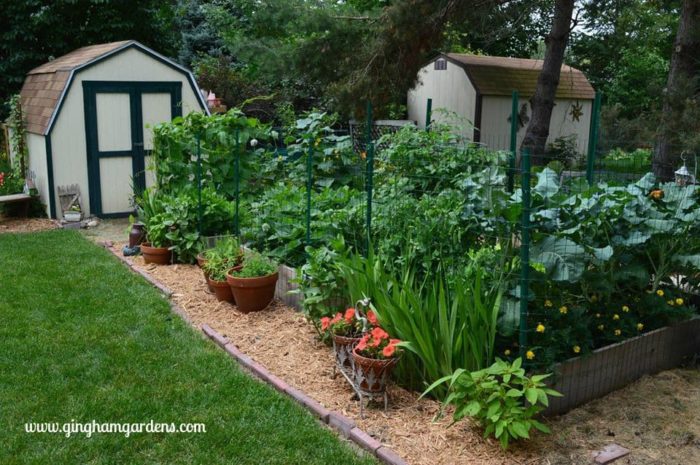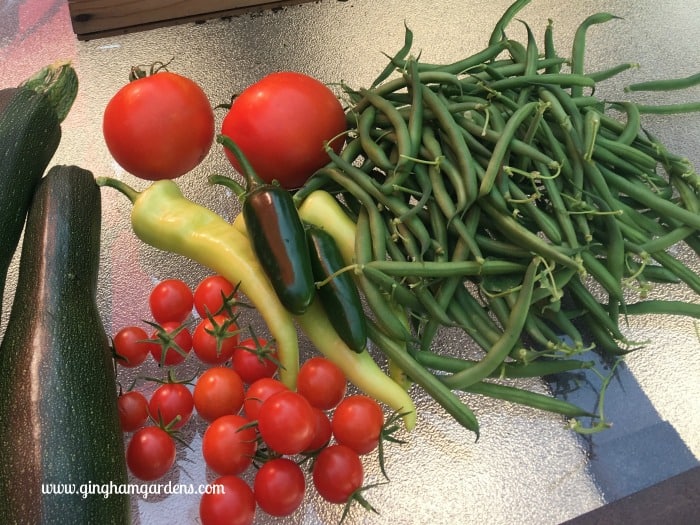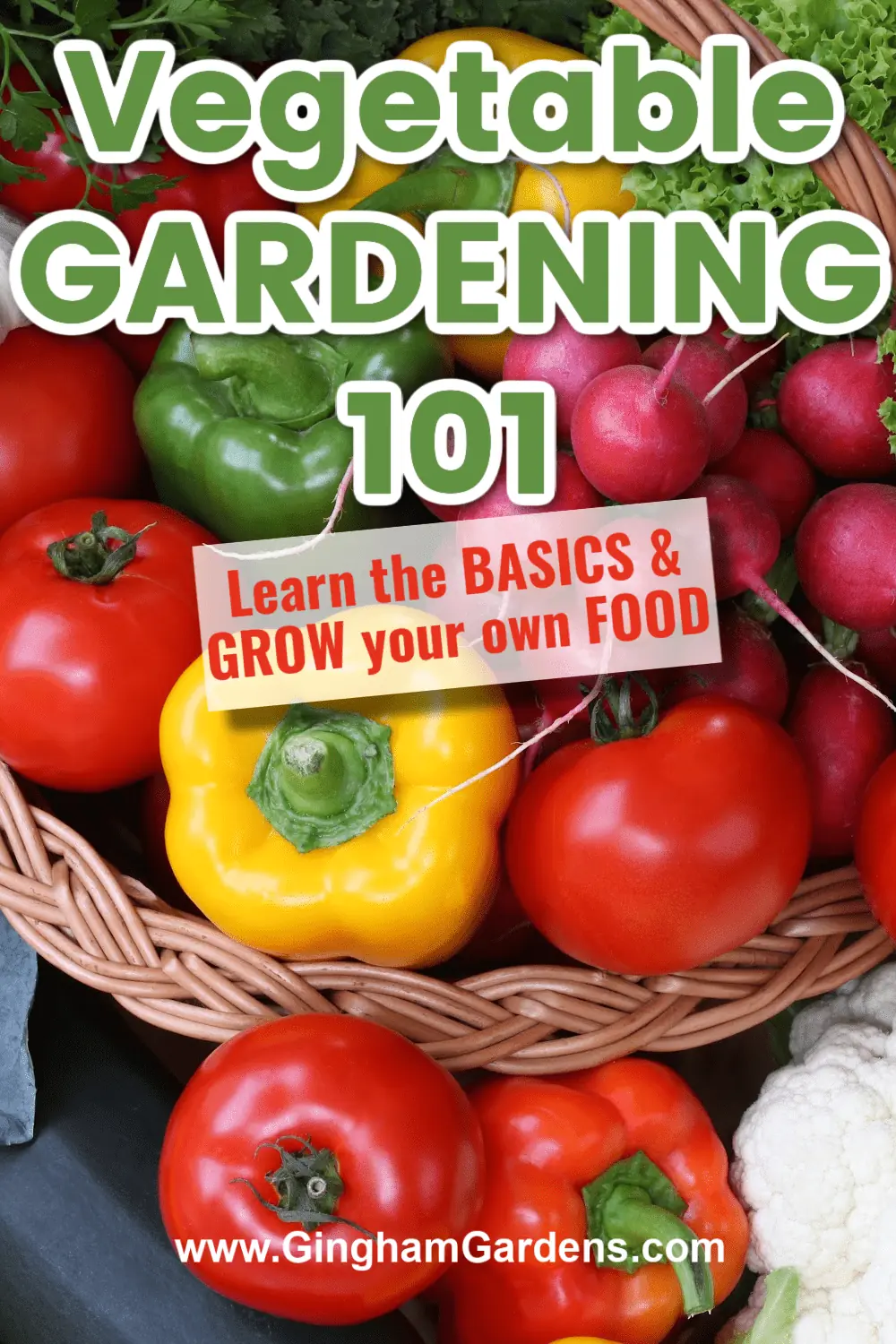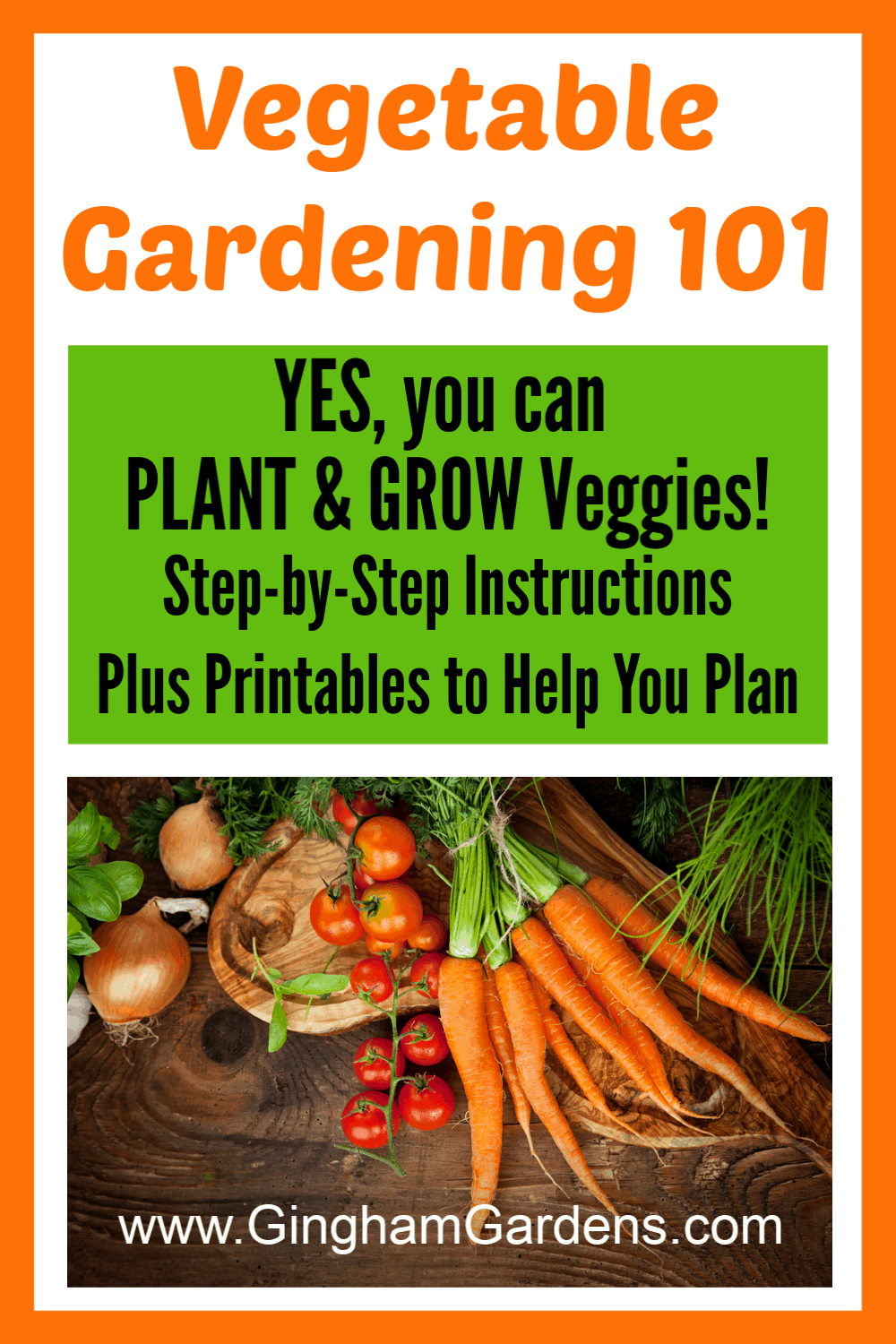Vegetable Gardening 101
There’s just something about growing your own food that is incredibly gratifying! My passion is flower gardening, but I love vegetable gardening too. And, oh my goodness, fresh homegrown vegetables are the absolute best! You, the gardener, are in control and know exactly what goes into growing those veggies.
Vegetable gardening is a part of my heritage. There were seven kids in my family and I can remember having a vegetable garden every summer. My dad would make us get up at the crack of dawn (in the cool of the day, he would say) to pull weeds and tend to the garden. This was no little garden with raised beds either, it was an old-fashioned, huge garden cut right into the ground. After all, we had a family of 9 to feed and the neighbors and families in need. Said with a note of sarcasm, but really with a heart of gratitude for the lessons that were taught. Of course, we moaned and complained about getting up early and we all swore we’d never have a garden when we grew up; and yet, most of us do. Can any of you relate to this story?
Is it Hard to Grow Vegetables?
I don’t think planting seeds, tending your crops and harvesting vegetables is difficult. Well okay, if you go big, it’s definitely hard, manual labor, but it’s not mentally hard. Oh, and you don’t have to have a “green thumb” (whatever that means) to plant and tend a garden. I think pretty much anyone can plant a garden and grow their own food. Yes, it’s that easy. Even if you don’t have space, tons of vegetables can be grown in containers. So pretty much if you have the desire, growing vegetables is not hard. Laborious, yes. Difficult, no.
As always, I will do my best to craft a tutorial according to what has worked for me. So, we’re going to keep Vegetable Gardening 101 very, very simple – just because it is!
If you are new to vegetable gardening, you might want to take a few minutes to read through Flower Gardening 101. There are many tips and instructions in that post that apply to vegetable gardening as well.
This post contains affiliate links. If you click on
one of the links and make a purchase,
I may receive a small commission at no additional cost to you.
See full disclosure here.
Recommended Gardening Tools and Supplies:
- Soil – Really, we actually purchase a compost mix for our veggie beds. Or, if you’re lucky, you can get it free. Check with your county.
- Seeds or Starter Plants
- Tomato Cages (for tomatoes and growing other veggies vertically)
- Rake
- Hoe
- Garden Hose
- Shovel (I love this shovel! Best. Shovel. Ever.)
- Hand Tools
Save a pin to your gardening board on Pinterest, so you can come back later:
Vegetable Gardening 101 – Choosing the right Spot for Your Vegetable Garden
Pick a spot of real estate in your yard that gets full sun – that’s 6 or more hours of sunlight per day. Your vegetables will produce better and taste better in full sun. I don’t care how many Pinterest pins you can find (and there are plenty) that say “10 Vegetables That Grow In The Shade” blah, blah, blah… Sorry to disappoint, but vegetables need sun to grow.
One of the most important things is to make sure your new garden is close to a water source.
If this is your first vegetable garden, start with just a small garden. You might even want to consider trying some vegetable plants in containers.
Prepare the Garden Area for Planting
If you aren’t going to use raised beds (see below), you’ll need to clear out space for an in-ground garden. You can do it the hard way by digging up all the grass and weeds, or if you aren’t in a hurry, you can use what’s called the Lasagna Method. Use a garden hose or rope and lay it out to mark the edge of the garden. Now, clear out all the grass and weeds. This is hard work and another reason to start small. It really helps to have a good sharp shovel that will cut through the sod and weeds.
Amending Your Soil
Next, it’s a good idea to amend the soil. The easiest way to do this is to mix in a good amount (like 4 or 5 inches on top of your existing soil) of good organic matter (compost). Don’t skip this! Healthy soil = Healthy Plants!
Check to see if there is a compost site available in your county, where you can pick up free compost. If not, it’s easy to find bagged compost at most big box stores.
After the compost has been mixed in, rake over the entire area to smooth and level it out. Now you have a blank slate with which to plan out and plant your veggie bed. I love dirt and this part always excites me. And, yes, I realize I’m a little strange! To learn more about ways to convert lawn into gardening space, I have an entire post on that subject. It’s important, so be sure to check it out when you’ve finished here.
When to Start Your Garden in Spring
You need to know the last frost date for your gardening zone. The best way to find this information is by going here and entering your zip code. Also, pay close attention to the extended weather forecast. Many cool-weather crops like lettuce, spinach, broccoli, peas and radishes, can tolerate a frost. However, warm-season crops like peppers and tomatoes will not enjoy frost and likely won’t survive.
Consider Raised Beds for your Vegetable Garden
Raised garden beds are a good choice. If you can afford them, go with raised bed gardens! If you want to cut out garden bed preparation, go with a raised garden bed.
There are lots of pre-made kits available. I would recommend that the bed be at least 8 inches deep and made of cedar, or some type of vinyl or composite material. My current raised veggie beds are 4 x 4, but I so wish we would have went with these 4 x 8 raised garden beds or these vinyl raised garden beds. We recently purchased these attractive, galvanized raised garden beds and I’m really excited to use them this spring.
If you’re going to go to the trouble of actually building raised beds, I would highly recommend using cedar. Cedar is very slow to show wear and rot. Concrete blocks, landscape blocks and large field stones can also be used for raised beds.
If you do decide to go with a raised bed, be sure to fill it to the top with a good mix of compost and top soil. Don’t skimp on filling your raised beds. It defeats the purpose of using raised beds if you don’t fill them to the top with soil. Besides, the soil will settle over time. We used to be able to purchase what was referred to as a 3-way mix, which was compost, top soil and sand. I could grow the best vegetables in that mix. Check out the article – How to Fill Raised Garden Beds, it is full of excellent information and tips for filling your raised beds cheaply and properly.
A Few Good Reasons to Consider Raised Garden Beds
- Eliminates ground weeds from your garden soil.
- The soil doesn’t become as compacted.
- Raised beds provide excellent drainage.
- You don’t have to bend over quite as far.
- They look great!
Vegetable Gardening in a Small Space
If you don’t have a lot of space for a backyard vegetable garden, you can still grow vegetables in a small space. We have an entire post dedicated to growing veggies in a small space. Stop by and check it out when you finish here.
And it can be a bit overwhelming for a new gardener.
To make it easier to grasp, I’ve created a PDF printable Workbook/Guide
of this post, which includes all the information in this
Vegetable Gardening 101 article, plus more helpful information,
some planning graphs and other checklists
to get you started on your way to growing your
own fresh, delicious vegetables.
The Vegetable Gardening 101 Guide & Workbook is
available for the low introductory price of $5.00.
Simply click the button below and follow the instructions.
(Be sure to check the box to receive free updates to the Guide.)

Tips for Planning A Vegetable Garden for Beginners
It’s important to take some time in early spring to plan out your garden space. We have a couple of useful printables in the Gardening Resources Library for you to create your own garden plans. If you’re a beginner gardener, keep it simple and remember the following pointers:
- Run your vegetable rows from north to south for the best sun exposure.
- Think about how you place your plants so taller ones don’t block the sun for shorter ones.
- Add in some marigolds and nasturtiums for pops of color and as a bug deterrent.
- Add some herbs.
- Crop rotation is important, so keep your garden plans in a binder so you can refer back to them next year.
If you are a beginner, or if you are and you’re interested in learning more, here’s a good read on Companion Planting.
Choosing Which Vegetables to Plant
Choosing which vegetables to plant goes hand-in-hand with planning out your veggie bed. It really helps to decide which vegetables you want to plant before you even go shopping for plants or seeds. Again, if you’re a beginner, keep it simple and consider picking just 5 or 6 of your favorite vegetables for your first year. Check out my free printable list of Easy to Grow Vegetables, which includes tips and notes for growing.
Certain plants are best planted from seed and it’s better to buy starter plants for others. If you live in warmer gardening zones, you can simply direct sow seeds for most of these vegetables directly in your garden.
Another important point to note is that root vegetables like carrots, potatoes, beets, radishes, etc. do no like to be transplanted and will need to be planted directly in your garden from seed.
Best Veggies to Grow from Seed:
Best Veggies to Grow from Starter Plants:
- Melons (seeds are fine too)
- Cucumbers (seeds are fine too)
- Tomatoes
- Squash (seeds are fine too)
- Broccoli
- Peppers
- Celery
- Cabbage
- Cauliflower
- Pumpkins (seeds are fine too)
Vegetable Gardening 101 – How to Plant Vegetables
After you’ve done some reading, prepped your bed for planting and amended your garden soil, decided which vegetables to plant and purchased your plants and seeds, it’s time to plant. This is where things get very simple, simply follow the directions for planting on the seed packet or the tag that comes with the vegetable plant. Pay attention to spacing and once the seeds start sprouting, be ready to thin some out. Really, it’s that simple.
Because I don’t like thinning out vegetables, I love using seed tape for carrots, radishes, spinach and lettuce. Seed tape is a little more expensive than just buying seeds, but I believe you will find that the little extra expense is totally worth it.
Additional Tips and Maintenance for Vegetable Gardens
Fence in your veggie bed. You don’t want to do all this work just to have your produce eaten by rabbits. Be sure the fencing is small enough that baby bunnies can’t get through it. Also, make sure bunnies can’t get under the fencing.
-
- Water. It seems silly to mention it, but your little baby plants need it. A good rule-of-thumb to follow is to water newly seeded areas and plants every day if you don’t get adequate rainfall. By late spring and continuing throughout summer (once the plants and seedlings are established) water less often like 1-3 times a week (depending on rainfall), but more deeply to encourage roots to grow deep. Just be consistent with your watering regimen and you’ll have much better success. Just a note: raised beds and container gardens typically need to be watered more often because they are above the ground. If trying to figure out how much water your garden and plants are actually getting totally befuddles you, this moisture meter is just the gadget you need. Learn more about efficiently watering your garden.
- Consider mulching between the rows and around the plants in your garden. You can use dried grass clippings (that haven’t been chemically treated), shredded leaves or shredded mulch. Mulch helps cut down on weeds, helps to hold moisture in the soil around your plants, and nourishes the soil.
- Stay on top of weeding! If you let the chore of weeding go, the weeds will overtake your garden very quickly.
- Fertilize – I recommend using an organic fertilizer for vegetables. Simply follow the directions for the fertilizer you select.
- Make planting and caring for a vegetable garden a family affair and include your children. There are so many lessons that can be taught when planting and caring for a garden, plus, it really can be fun.
Other Helpful Gardening Articles:
Seed Starting Indoors
11 Flower Gardening Mistakes (also applies to Veggie Gardens)
Flower Garden Maintenance (also applies to Veggie Gardens)
Practical Tips for Spring Garden Cleanup
Thanks for stopping by today and following along with Vegetable Gardening 101. Whether you’re a beginner gardener or an experienced gardener, I hope you learned something and you’re inspired to plant a vegetable garden. What vegetables are you going to grow in your garden this year? Do you have gardening questions? If so, please leave a comment and I’ll get back to you just as soon as I can.
Happy gardening,
Joanna
And it can be a bit overwhelming for a new gardener.
To make it easier to grasp, I’ve created a PDF printable Workbook/Guide
of this post, which includes all the information in this
Vegetable Gardening 101 article, plus more helpful information,
some planning graphs and other checklists
to get you started on your way to growing your
own fresh, delicious vegetables.
The Vegetable Gardening 101 Guide & Workbook is
available for the low introductory price of $5.00.
Simply click the button below and follow the instructions.
(Be sure to check the box to receive free updates to the Guide.)
More Great Things on Gingham Gardens
Sign up to receive our weekly newsletters full of gardening tips. You’ll also get access to our Gardening Resources Library and all our helpful gardening printables.
More places to find Gingham Gardens:
- Visit Gingham Gardens on Pinterest.
- If you’re on Facebook, Gingham Gardens is also on Facebook.
- Stop by Gingham Gardens’ Amazon store!
- Love Etsy? Come see us on Etsy too.
Save a pin to your gardening board on Pinterest, so you can remember this post later:

